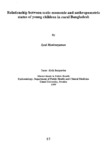Relationship between socio-economic and anthropometric status of young children in rural Bangladesh
Date
1999Publisher
BRAC Research and Evaluation Division (RED)Author
Moniruzzaman, SyedMetadata
Show full item recordCitation
Moniruzzaman, S. (1999). Relationship between socio-economic and anthropometric status of young children in rural Bangladesh. Research Reports (1999): Social Studies, Vol – XXII, 83–116.Abstract
This study investigates the interrelationship between socio-economic status and
anthropometric measurements of young children in rural Bangladesh.
A nutrition surveillance system programme (the NSP) was established in April 1990. This is a
collaborative effort that involves international and indigenous non-governmental
organisations (NGO) and the government of Bangladesh, and is co-ordinated by Helen Keller
International and funded by the US Agency for International Development. Data were
collected every two months by ten NGOs and the Bangladesh government from 26 sentinel
points, corresponding to 20 subdistricts and 4 urban slums. In each round of data collection,
5000-6000 households are randomly selected, and anthropometric measurements are taken
from 7,000-9,000 children between the ages of 6 and 59 months. Data for this study came
from Mohanpur, Manda, Bhuapur and Dagonvhuiya subdistricts, the vital registration area of
the NGOs ASA, Shwanirvar Bangladesh and VERC. Anthropometric and socio-economic
data concerning 1562 children aged 6-59 months were collected. From these data, it was
found that the proportion of malnourished children was very high, underweight 59%, and
stunted 56%. Malnutrition of the child was related to low educational level of the mother and
poor condition of housing. Poor housing may be regarded as a proxy for poor socio-economic
conditions. The different characteristics of the socio-economic conditions of the household
were closely related, and not easily separated in relation to malnutrition of the child. The
conclusion of this study is that preventive efforts improving the socio-economic condition of
families with children and the educational level of mothers may have profound effects on
child health.

